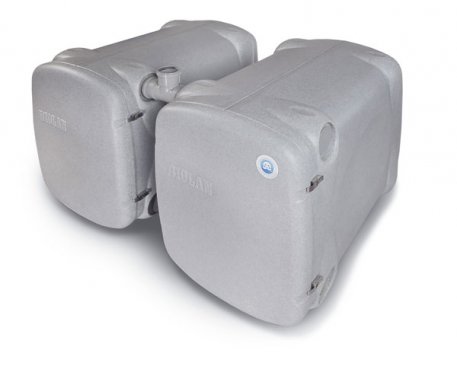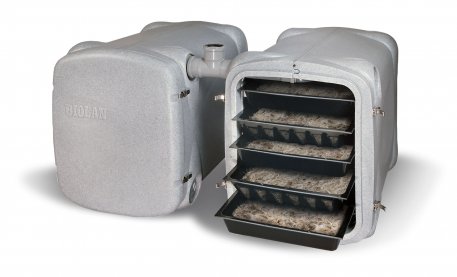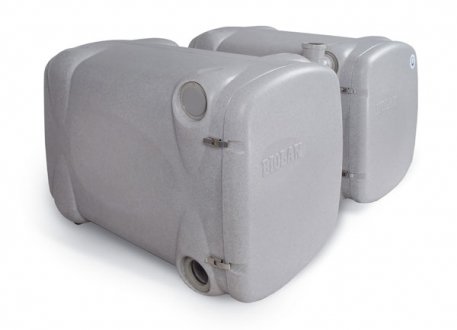Principle of operation
The operation of the filter is based on the mechanical and biological filtration of wastewater. Organic filter material, to which the dirt in the wastewater sticks, is used in the filter. The micro-organisms living on the surface of the filter material use the impurities as their nutrition.
Structure
The Greywater Filter 70 comprises two purifier units, i.e. modules. The incoming wastewater is distributed between the modules by means of the branch sleeve located between the modules. Both modules have five filter boxes placed one on top of the other. The wastewater is conducted into the uppermost filter boxes. Inside the filter, the wastewater flows by gravitation from one filter layer to the other through the openings in the end of the box.
The circulation of air inside the modules is natural: air flows in through the lower air valve in the rear wall and out through the upper valve. The oxygen supply to the micro-organisms is essential for the operation of the unit.
Planning and selecting the location
Building a wastewater system or changing it requires a building or action permission from the municipal building authority or submission of notification of action. The building permission is applied on submission of the relevant plan. The plan includes, among other things, a site plan and a cross-section presenting the height position.
Is to be placed above the ground
The Biolan Greywater Filter 70 is to be placed above the ground. Place the filter in a location, where water will no gather, not even when there is flooding. The purifier can be installed out of doors without covering. The unit is thermally insulated, which means it can be used in slight frost. If the filter is used in winter, it must, however, be equipped with the Biolan Heating Cable, which is available as an option, or the filter must be placed in a space, where the temperature stays above zero.
Location inside a residential building
Biolan Greywater Filters are primarily intended for installation out of doors. If the filter is to be installed indoors or in close proximity to a residential building (for example, under the terrace), it must be taken into account during the planning that this space needs to be provided with its own entrance for maintenance. The space must be provided with a floor well or an earthen floor for possible malfunctions.
The replacement air for the filter is taken from the end of the discharge pipe and the outlet air is conducted as sewer ventilation to the roof of the building. To avoid odour problems, the air valves need to be kept closed. The outlet air can also be led through the upper air valve in the rear wall of the filter into a separate outlet air channel. While installing indoors, the outlet air channel shall be equipped with a ventilator that keeps a slight vacuum inside the filter.
Whenever the Greywater Filter is located in a warm space in a residential building, or in close proximity to a residential building, the correct installation must always be verified with the expert in charge of planning the HVAC system of the building.
Leading wastewater to the filter
The wasterwater is conducted directly to the filter either using gravity flow drainage or a pump well. To ensure even distribution it is recommended to provide the inlet pipe with a straight part 80 cm long before the branch sleeve to reduce turbulation of the incoming water flow.
If existing sedimentation wells are utilised in connection with pumping, they need to be in good condition and hermetically sealed. The operation of the pump must be sequenced using a timer so that during one sequence the pump brings at maximum 20 litres of wastewater to the filter. The interval between the sequences must be at least 10 minutes. The Biolan Timer, the Submersible Pump and the Pump Well are available as options.
Principle drawings presenting gravity flow drainage and pumping
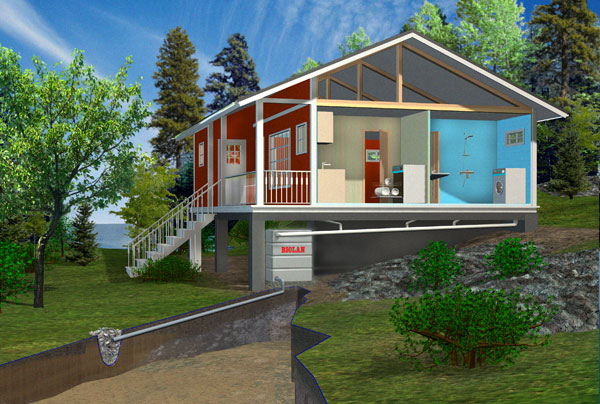
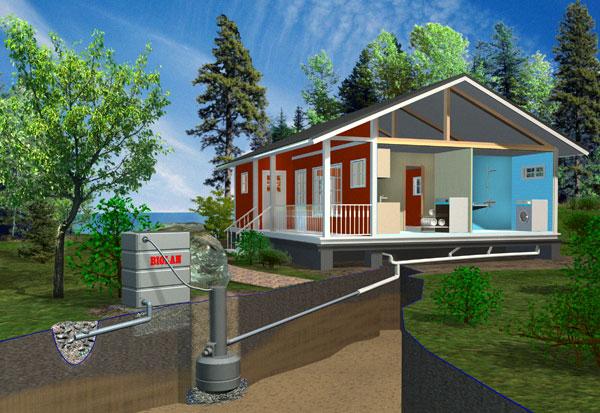
The space required for use and maintenance
The space required for use and maintenance measures must be taken into account while selecting the location. A free space at least one metre deep is required for changing the filter material in front of the unit. Sufficient space is required also at the side and in the rear of the unit so as to enable the maintenance of the outlet connector of the sewer and the adjustment of the air valves in the rear wall. The air valves must not be covered to ensure the oxygen supply to the micro-organisms.
Discharging wastewater
Coduct the treated wastewater to a suitable discharge point, for example a stone pocket or an open ditch. Observe during planning that the discharge of wastewater must be unobstructed and the end of the pipe must not be submerged even when the level of surface water or groundwater is high. If you lead the water to an open ditch, provide the end of the pipe with a flap or a net to prevent rodents or other small animals from gaining access.
